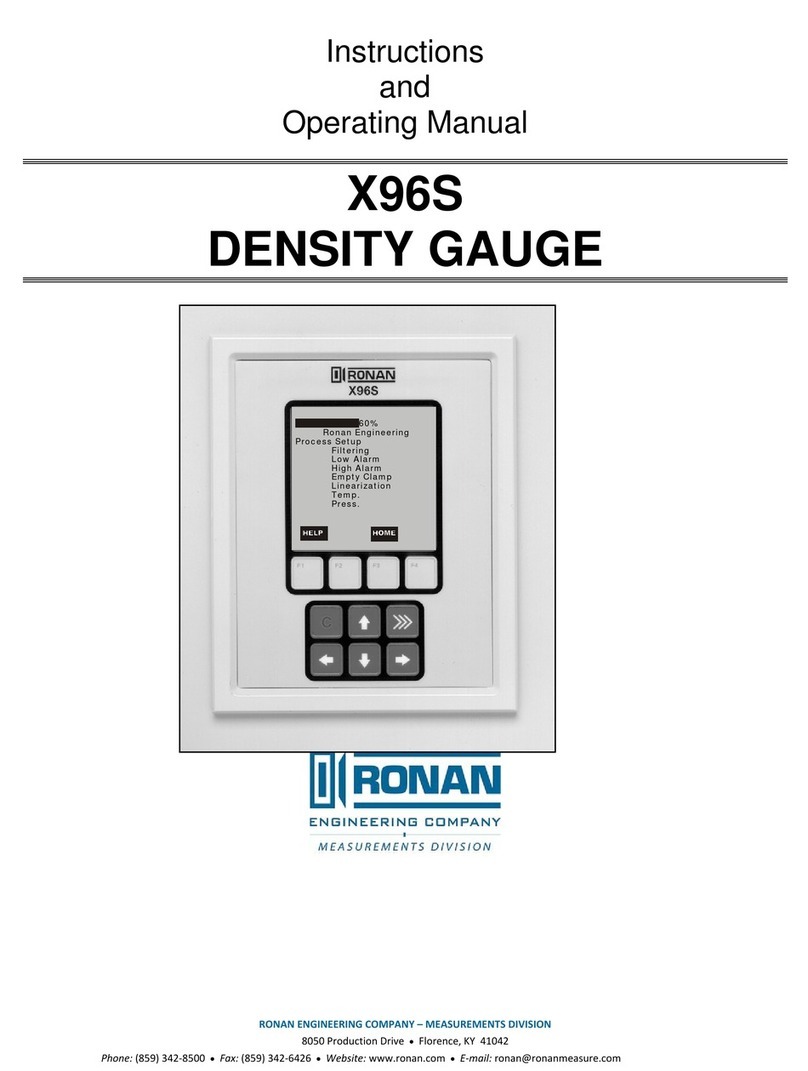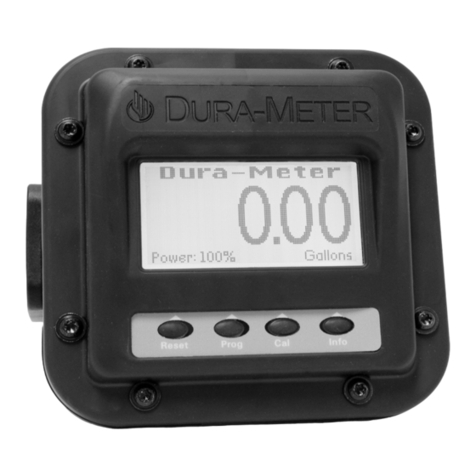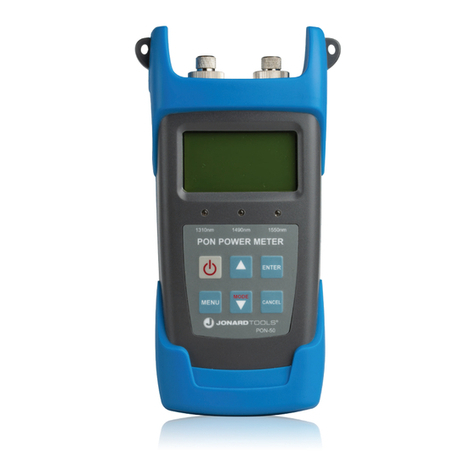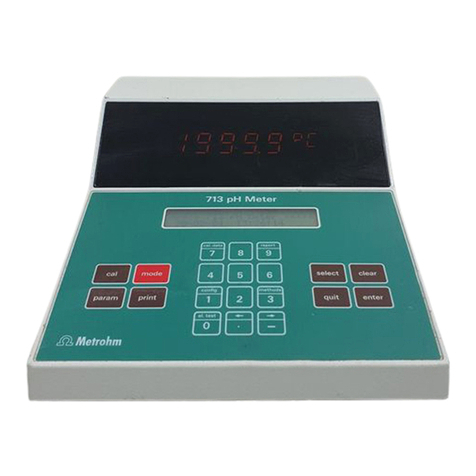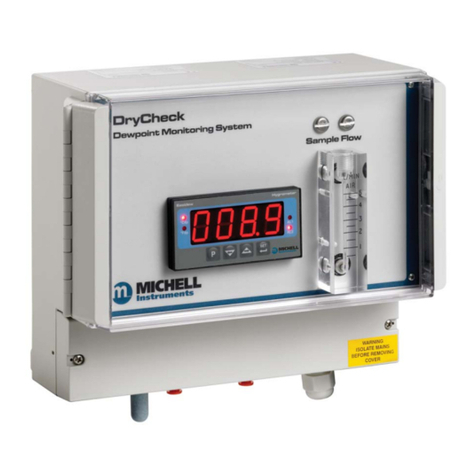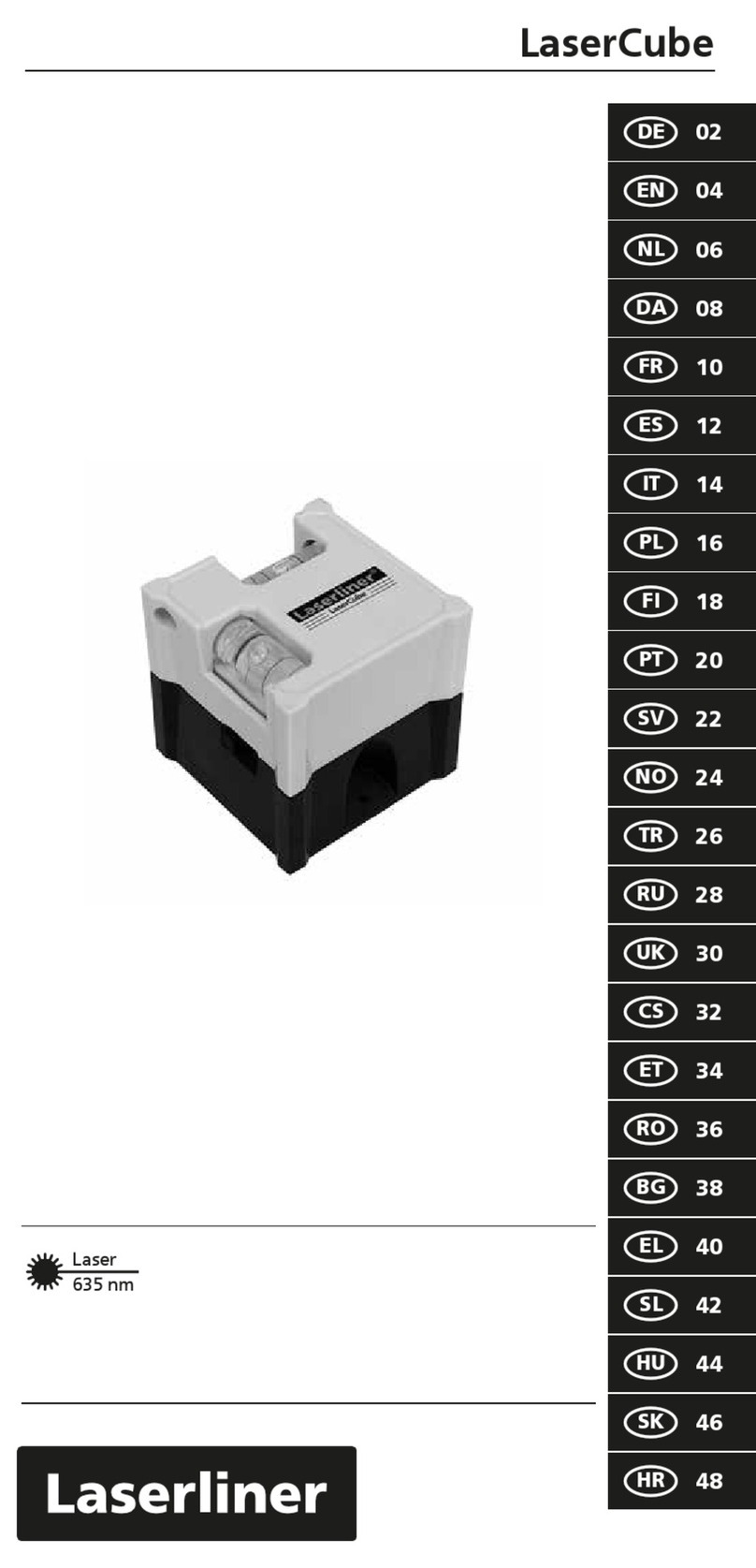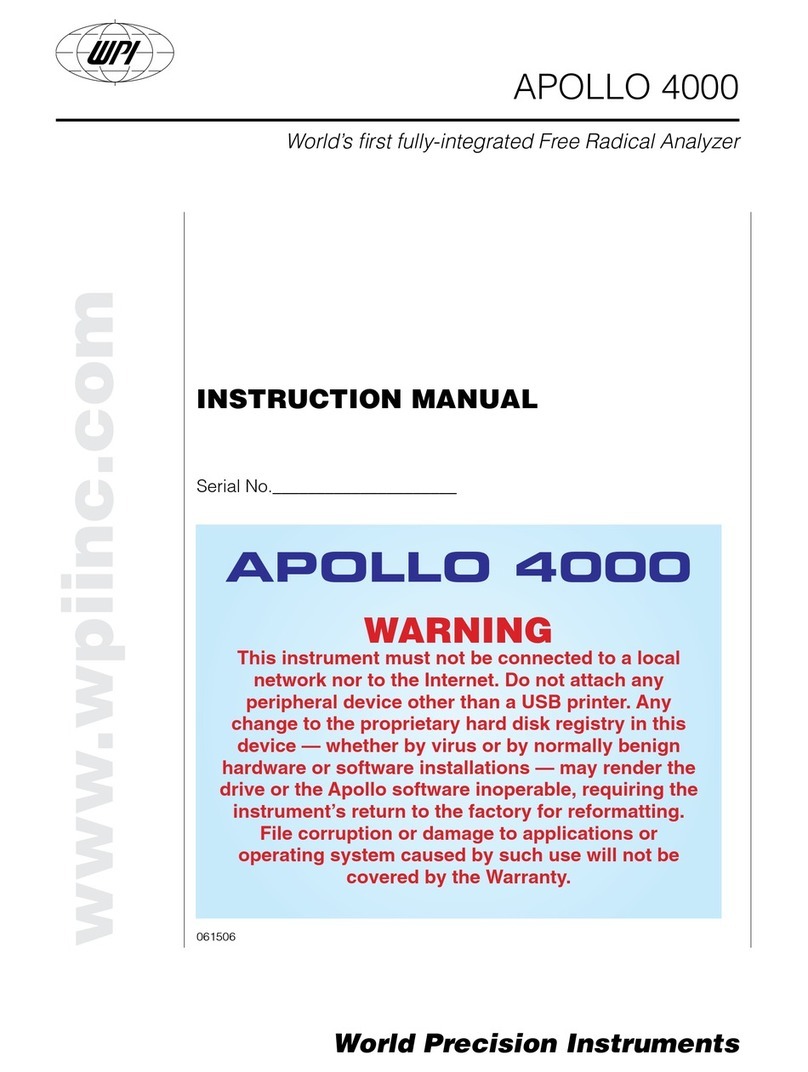Ronan Engineering X96S Parts list manual

RONANENGINEERINGCOMPANY–MEASUREMENTSDIVISION
8050ProductionDriveFlorence,KY41042
Phone:(859)342‐8500Fax:(859)342‐6426Website:www.ronan.comE‐mail:[email protected]
Instructions
and
Operating Manual
X96S
LEVEL GAUGE

RONANENGINEERINGCOMPANY–MEASUREMENTSDIVISION
8050ProductionDriveFlorence,KY41042
Phone:(859)342‐8500Fax:(859)342‐6426Website:www.ronan.comE‐mail:[email protected]
Updated09‐25‐2017
i
Table of Contents
OVERVIEW ....................................................................................................................................................................... 1
Advantages........................................................................................................................................................................ 1
Gamma's Advantages.................................................................................................................................................... 1
X96S Advantages.......................................................................................................................................................... 1
BASIC CONCEPTS........................................................................................................................................................... 2
Communications................................................................................................................................................................ 2
4-20 MA.......................................................................................................................................................................... 2
HART ............................................................................................................................................................................. 2
Variables............................................................................................................................................................................ 2
Communication Variables.............................................................................................................................................. 2
Device Variables............................................................................................................................................................ 2
Configuration Variables.................................................................................................................................................. 2
THEORY............................................................................................................................................................................ 3
Theory of Radiation Gaging............................................................................................................................................... 3
Principles of Operation...................................................................................................................................................... 4
PASSWORD...................................................................................................................................................................... 5
MENUS/OPERATION ....................................................................................................................................................... 6
Menu Trees........................................................................................................................................................................ 6
Root Menu....................................................................................................................................................................... 13
Variables Menu............................................................................................................................................................ 13
Variable Mapping Menu ........................................................................................................................................... 13
Status Display Menu.................................................................................................................................................... 14
Configuration Menu...................................................................................................................................................... 14
Operation Menu........................................................................................................................................................ 15
Linearization Menu................................................................................................................................................... 16
Level Config Menu ................................................................................................................................................... 16
Head Temp Config Menu......................................................................................................................................... 17
Hardware Menu........................................................................................................................................................ 18
Source Type Menu.............................................................................................................................................. 19
Flow Hardware Menu.......................................................................................................................................... 19
HART Menu.............................................................................................................................................................. 19
System Menu ........................................................................................................................................................... 20
Digital Outputs Menu ................................................................................................................................................... 20
Relay and TTL Menus.............................................................................................................................................. 20
Digital Inputs ................................................................................................................................................................ 21
TTL Menus22
Digital Inputs Menu.......................................................................................................................................................... 23
Input Menus ................................................................................................................................................................. 23
Auto Cal Menu................................................................................................................................................................. 23
Calibration Menu ............................................................................................................................................................. 25
Ref Constants Menu.................................................................................................................................................... 25
Calibrate Menu............................................................................................................................................................. 25
Low Reference Menu............................................................................................................................................... 26
High Calibrate Menu................................................................................................................................................. 26
Loop Config Menu........................................................................................................................................................ 26
Aux Loop Cfg Menu..................................................................................................................................................... 26
Diagnostics................................................................................................................................................................... 26

RONANENGINEERINGCOMPANY–MEASUREMENTSDIVISION
8050ProductionDriveFlorence,KY41042
Phone:(859)342‐8500Fax:(859)342‐6426Website:www.ronan.comE‐mail:[email protected]
Updated09‐25‐2017
ii
X96S LOCAL DISPLAY................................................................................................................................................... 27
Navigating Menus............................................................................................................................................................ 28
Editing Values.................................................................................................................................................................. 28
Editing Fixed Point Numbers ....................................................................................................................................... 28
Editing Floating Point Numbers ................................................................................................................................... 28
Editing Text Strings...................................................................................................................................................... 28
Editing Enumerated Values ......................................................................................................................................... 29
X96 Local Display Vs 275 Calibrator............................................................................................................................... 29
INSTALLATION............................................................................................................................................................... 30
Safety Precautions .......................................................................................................................................................... 32
Mechanical Mounting....................................................................................................................................................... 33
Electrical Installation of Interconnect Wiring.................................................................................................................... 34
Microprocessor Verification............................................................................................................................................. 35
Identification / Documentation...................................................................................................................................... 35
Power-up ......................................................................................................................................................................... 36
PASSWORD.................................................................................................................................................................... 37
CALIBRATION................................................................................................................................................................. 38
Reference Modes ............................................................................................................................................................ 38
Calibration.................................................................................................................................................................... 38
Low Reference......................................................................................................................................................... 38
High Calibration........................................................................................................................................................ 38
Preparation for Calibration........................................................................................................................................... 38
Documentation ................................................................................................................................................................ 42
CONFIGURATION .......................................................................................................................................................... 42
DETECTOR..................................................................................................................................................................... 43
Scintillator Detector ......................................................................................................................................................... 43
ION Chamber................................................................................................................................................................... 45
DETECTOR HOUSING/.................................................................................................................................... 46
ELECTRONICS............................................................................................................................................................... 48
SAMPLE DRAWINGS..................................................................................................................................................... 53

RONANENGINEERINGCOMPANY–MEASUREMENTSDIVISION
8050ProductionDriveFlorence,KY41042
Phone:(859)342‐8500Fax:(859)342‐6426Website:www.ronan.comE‐mail:[email protected]
Updated09‐25‐2017
1
Overview
The X96S is a family of measurement products that is intended to replace the obsolete X96N and current X99 product
families. These products:
use nuclear measurement techniques,
support all features of the obsolete X96N and current X99 products,
support up to 32 scintillation or ionization detectors,
optional HART interface,
improved user interface options1,
more user functionality, and
more product flexibility.
Advantages
Mounts External to Existing Vessels
Displays in Customer Units
Most Applications can be solved with low-energy sources
Not affected by:
-extreme temperatures
-caustic processes
-sterile processes
Gamma's Advantages
Mounts external to pipe or vessel (no components exposed to process material)
Passes through process material
Does not make material radioactive
Does not change the material
Can be shielded by lead
X96S Advantages
HART Communications
Identical interface on local display as via HART
Blind transmitter in detector on self-contained design
Custom configuration of display
Surface, panel or rack mount available
Field mountable
Push button calibration
1This includes the ability to have a simple or complex user interface, a remote user interface, or even no user interface.

RONANENGINEERINGCOMPANY–MEASUREMENTSDIVISION
8050ProductionDriveFlorence,KY41042
Phone:(859)342‐8500Fax:(859)342‐6426Website:www.ronan.comE‐mail:[email protected]
Updated09‐25‐2017
2
Basic Concepts
Communications
The Ronan X96S Level gage provides both 4-20 mA current loop and HART communications.
4-20 MA
For many years, the field communication standard for process automation equipment has been a 4-20 mA current loop
signal. The current varies in proportion to the process variable being represented. In typical applications, a signal of
4mA will correspond to the lower limit (0%) of the calibrated range and 20mA will correspond to the upper limit (100%)
of the calibrated range. Thus, if the system is calibrated for 1 to 3 feet, then an analog current of 12mA (50% of range)
will correspond to a level of 2 feet.
HART
HARTField Communications Protocol extends the 4-20mA current loop standard to enhance communication with
smart field instruments. The HART protocol was designed specifically for use with intelligent measurement and control
instruments which traditionally communicate using 4-20mA analog signals. HART preserves the 4-20mA signal and
enables two-way digital communications to occur without disturbing the integrity of the 4-20mA signal. Unlike other
digital communication technologies, the HART protocol maintains compatibility with existing 4-20mA systems, and in
doing so, provides users with a backward compatible solution. HART Communication Protocol is well established as
the "de facto" industry standard for digitally enhanced 4-20mA field communication.
The enhanced communications capability of intelligent field instruments employing the HART protocol, offers
significantly greater functionality and improved performance over traditional 4-20mA analog devices. The HART
protocol permits the process variable to continue to be transmitted by the 4-20mA analog signal and additional
information pertaining to other variable, parameters, device configuration, calibration, and device diagnostics to be
transmitted digitally at the same time. Thus, a wealth of additional information related to plant operation is available to
central control or monitoring systems through HART communications.
Variables
There are two types of variables, communications variables and device variables.
Communication Variables
HART defines four device variables, PV (Primary Variable), SV (Secondary Variable), TV (Tertiary), and QV
(Quaternary). PV is assigned to the primary 4-20 ma loop. HART is also communicated over this loop. SV is assigned
to an optional secondary 4-20 ma loop.
Device Variables
The Ronan X96S Level gage has 2 device variables:
Device Variable
V
alue
Level Level
Head Temp Head Temperature
Configuration Variables
The Ronan X96S Level gage has many configuration variables that are accessed through its menus.

RONANENGINEERINGCOMPANY–MEASUREMENTSDIVISION
8050ProductionDriveFlorence,KY41042
Phone:(859)342‐8500Fax:(859)342‐6426Website:www.ronan.comE‐mail:[email protected]
Updated09‐25‐2017
3
Theory
Theory of Radiation Gaging
Radiation gages operate on the principle of radiation absorption and transmission.
A beam of gamma radiation is directed from the source holder, through the vessel and its process material, and onto
the surface of the detector.
Radiation which is not absorbed by the material through which it passes, is transmitted to the surface of the detector.
Process measurement is possible because the amount of radiation absorbed and transmitted is predictable.
The absorbed radiation is directly related to the level of process material in the vessel while the transmitted radiation is
inversely related to the level of process material in the vessel.
Therefore, an increased process level results in a decrease of transmitted radiation.
Since the radiation that's not being absorbed is being transmitted, the process level can be inferred by measuring the
amount of radiation reaching the detector at any point in time. The detector's output signal, in counts, also varies
inversely to the process level.
When the process level is low the detector is exposed to a maximum amount of radiation which produces a HIGH
output of counts. When the process level is high the process material "shields" the detector and prevents radiation
from reaching the detector, producing a LOW output of counts.
The X96S Microprocessor converts the detector signal to user's measurement units of level: m, mm, cm, in, ft.
The X96S displays the output measurement range in the selected user units. The "zero" of the measurement range
represents the lowest level of interest, while the "span" of the measurement range represents the highest level of
interest.
Reduction of the signal "noise" due to radiation statistics is handled in the stage of signal processing known as digital
filtering. Digital filtering is a form of statistical averaging used to smooth, or dampen, random radiation as well as
process-related noise. Increasing the digital filter’s “time constant” decreases signal noise.
Dynamic tracking permits the gage response to temporarily by-pass the digital filter. This is helpful in some processes
where sudden or drastic step changes in process must be observed in their true, or unfiltered, state.
Software also compensates for the decay of the radioactive source activity. On-going adjustments are made
automatically for the rate of decay, or source half-life.

RONANENGINEERINGCOMPANY–MEASUREMENTSDIVISION
8050ProductionDriveFlorence,KY41042
Phone:(859)342‐8500Fax:(859)342‐6426Website:www.ronan.comE‐mail:[email protected]
Updated09‐25‐2017
4
Principles of Operation
The detector's raw output signal is processed through several stages of software in the X96S.
Some of the more significant stages of signal processing are:
Units Conversion – conversion of counts into user-selected level units
Measurement Range – 4-20 mA output defined by the user-selected range in user-selected units.
Digital Filtering – signal smoothing to reduce statistical radiation noise
Dynamic Tracking – quick gage response to quick process changes.
Source Decay Compensation – automatic compensation for the radioisotope decay
Calibration (Referencing) – calibration of gage to user process.
The Calibration (or Referencing) procedure relates detector output (in counts) to numeric values that accurately
represent the actual process level.
The level algorithm used by the X96S software is a simple transfer function. That is, the relationship between the
detector output and the process level is mathematically expressed as:
0
0
0
0LL
II II
LLevel f
f
Where:
If= detector signal with calibrate (full) level (Lf) in vessel
Io = detector signal with reference (low) level (L0) in vessel
I = current detector signal
L0= level @ reference (low level)
Lf= level @ calibration (high level)

RONANENGINEERINGCOMPANY–MEASUREMENTSDIVISION
8050ProductionDriveFlorence,KY41042
Phone:(859)342‐8500Fax:(859)342‐6426Website:www.ronan.comE‐mail:[email protected]
Updated09‐25‐2017
5
Password
Notice:
To access the Programming Menu, the Password is 101010.
Step 1: Power Up – You should now be on the Status Screen.
Step 2: Press F3 to go back.
Step 3: Now enter the password. (All digits are set at 000000 at this point.)
Press to get the digit to be # one
Press 2 times (The third digit should be highlighted.)
Press to get the digit to be # one
Press 2 times (The fifth digit should be highlighted.)
Press to get the digit to be # one
Press F4 (enter)
Note: If the wrong password was entered, press F1 (ALL0) to set all the digits to the
number 0 and you can begin re-entering the password from the beginning. Pressing F2
(RST0) will set the individual digit that is highlighted back to the number 0.
Note: For security reasons, each digit will always be displayed as an asterisk.

RONANENGINEERINGCOMPANY–MEASUREMENTSDIVISION
8050ProductionDriveFlorence,KY41042
Phone:(859)342‐8500Fax:(859)342‐6426Website:www.ronan.comE‐mail:[email protected]
Updated09‐25‐2017
6
Menus/Operation
Menu Trees
The Ronan X96S Level Gauge uses a tree structured menu system.
Ronan X96S
–
Level
V
ariables
V
ariables
Status Display
Configuration
2
V
ariable Mapping
V
ariable Mapping
Digital Outputs 4 PV [value units]
Digital Inputs 4 SV [value units] PV is [var mapped to PV]
Auto Cal
5
TV [value units] SV is [var mapped to SV]
Calibration 5 QV [value units] TV is [var mapped to TV]
Diagnostic Level [value units] QV is [var mapped to TV]
Head Temp [value units]
Raw Cnts [value]
V
ar [options]
Filt Counts [value] Level
Head Temp
Not Assigned
Status Display
Analog Bar [enable/disable]]
Line 1: [var]
Line 2: [var]
Line 3: [var]
Line 4: [var]
Line 5: [var]
Line 6: [var]
Line 7: [var]
Line 8: [var]
Var [options]
Level
Raw Level
Head Temp
4-20 mA
Raw Cnts
Filt.Cnts
Date & Time
Diagnostic
Not Assigned
Figure 3-1 – Root, Variables and Displays Menus

RONANENGINEERINGCOMPANY–MEASUREMENTSDIVISION
8050ProductionDriveFlorence,KY41042
Phone:(859)342‐8500Fax:(859)342‐6426Website:www.ronan.comE‐mail:[email protected]
Updated09‐25‐2017
7
Configuration
Operation Operation
Level Config
Head Temp Config Filtering Filtering
Alarms
2
Detector Fault
Hardware 2 Linearization Type
HART
2
Scan Time [ms] Dyn Track [enable/disable]
System
2
Sigma [value]
Fast TC [seconds]
Fast Counter [value]
Medium TC [seconds]
Level Config Slow Counter [value]
Slow TC [seconds]
Units [units] Noise Filter [0]
Low Range [number] Monitor [status]
High Range [number]
Detector Fault
Min Counts [counts]
Head Temp Config Max Counts [counts]
Head Temp Units [units] Linearization
Low Range [number]
High Range [number] Linearize [enable/disable]
Table Entry # [number]
Entry Used [yes/no]
Measured [value]
Actual [value]
Clear Table
Figure 3-2 – Configuration Menus (1 of 3)

RONANENGINEERINGCOMPANY–MEASUREMENTSDIVISION
8050ProductionDriveFlorence,KY41042
Phone:(859)342‐8500Fax:(859)342‐6426Website:www.ronan.comE‐mail:[email protected]
Updated09‐25‐2017
8
Continued from previous page
Configuration
Operation Alarm (number)
Level Config
Head Temp Config Source [variable]
Alarms Alarm Type [variable]
Hardware
A
larms Setpoint [SGU]
HART Alarm 1 Setpoint 2 [SGU]
System Alarm 2 Hysterisis [%]
Alarm 3
Alarm 4
A
larm on 4-20mA
Alarm 5 None
Alarm 6 Underrange
Alarm 7 Overrange
Alarm 8 Freeze
Alarm on 4-20 m
A
System Hardware
Hardware [read only]
System Hardware CPU Card [part no.]
Source Type Slot 1 Details
Analog Out Config Slot 2
Flow Hardware Ion/Scint#2 Slot 2 Details
Com1 Protocol Ronan Slot 3
Slot 3 Details
Slot 4
Slot 4 Details
Slot 5
Slot 5 Details
Slot 6
Slot 6 Details
Slot 7
Slot 7 Details
Slot 8
Slot 8 Details
Display [part no.]
Display Details
Field Interface [part no.]
HART DB Details
Details for Sys Hardware
Device Status
Serial Numbe
r
SW Major Rev [software ver]
SW Minor Rev [software ver]
HW Rev
Source Type
Source Type [type]
User Def Source [S.O.#]
Next Reference [date]
Next Wipe Test [date]
Next Shutter Test[date]
Figure 3-2 – Configuration Menus (2 of 3)

RONANENGINEERINGCOMPANY–MEASUREMENTSDIVISION
8050ProductionDriveFlorence,KY41042
Phone:(859)342‐8500Fax:(859)342‐6426Website:www.ronan.comE‐mail:[email protected]
Updated09‐25‐2017
9
Continued from previous page
Configuration Hardware (Cont’d)
Operation System Hardware
Level Config Source Type
Head Temp Config Analog Out Config
Alarms Flow Hardware [read only]
Hardware Com1 Protocol
A
nalog Out Config
Hart
System Loop 1 (PV) [variable]
Loop 2 (SV) [variable]
HART Loop 3 (TV) [variable]
Power Source [int/ext]
Tag Name [S.O. No.]
Multi Drop [number] Flow Hardware
Univ Rev [read only] [Read Only]
Spec Rev [read only] Pulse
Tachomete
r
System Ion/Scint ch#2
None
Serial # [read only]
Hardware Rev [read only] Com1 Protocol
Software Rev [read onl
y
]
Date [date] None
Hour (0-23) [hour] Hart
Minute [min] Modbus
Password Ronan Setup
Date/Time Format [sel]
Figure 3-2 – Configuration Menus (3 of 3)

RONANENGINEERINGCOMPANY–MEASUREMENTSDIVISION
8050ProductionDriveFlorence,KY41042
Phone:(859)342‐8500Fax:(859)342‐6426Website:www.ronan.comE‐mail:[email protected]
Updated09‐25‐2017
10
Digital Outputs Output
[select]
Output Relay 1
Select Sources Relay 2
Polarity Relay 3
Relay 4
TTL 1
TTL 2
TTL 3
TTL 4
Select Sources
Output [type] Output
Alarm 1 [yes/no] [select]
Ala
r
m 2 [yes/no] Relay 1
Alarm 3 [yes/no] Relay 2
Alarm 4 [yes/no] Relay 3
Alarm 5 [yes/no] Relay 4
Alarm 6 [yes/no] TTL 1
Alarm 7 [yes/no] TTL 2
Alarm 8 [yes/no] TTL 3
Auto Cal Ref [yes/no] TTL 4
Auto Cal Err [yes/no]
Ref Prompt [yes/no]
Wipe Test [yes/no]
Shutter Test [yes/no]
Empty Clamp [yes/no]
Detector Flt [yes/no]
System Alarm [yes/no]
Polarity
No/Not Driven
NC/Driven
Open/Not Driven
Digital Inputs Closed/Driven
Input 1 Input 1….8 Polarity
Input 2 Low
Input 3 Polarit
y
High
Input 4 Type
Input 5
Input 6 Type
Input 7 Manual
Input 8 Sensor Rise
Sensor Fall
Sensor Both
Figure 3-3– Digital Output and Digital Input Menus

RONANENGINEERINGCOMPANY–MEASUREMENTSDIVISION
8050ProductionDriveFlorence,KY41042
Phone:(859)342‐8500Fax:(859)342‐6426Website:www.ronan.comE‐mail:[email protected]
Updated09‐25‐2017
11
Auto Cal
A
uto Cal Setup Auto Cal 1…8
Auto Cal Setup Auto Cal 1 Auto Cal [Enable/Disable]
AutoCal Capture Auto Cal 2 Level [value]
Auto Cal Status Auto Cal 3 Trigger Delay [value]sec
Auto Cal 4 Source
Auto Cal 5 AC1 State [Read only]
Auto Cal 6
Auto Cal 7
Auto Cal 8
A
utoCal Source
None
Capt.Cnts AC1 [Read Only Cts] DI1
Capt.Cnts AC2 [Read Only Cts] DI2
Capt.Cnts AC3 [Read Only Cts] DI3
Capt.Cnts AC4 [Read Only Cts] DI4
Capt.Cnts AC5 [Read Only Cts] DI5
Capt.Cnts AC6 [Read Only Cts] DI6
Capt.Cnts AC7 [Read Only Cts] DI7
Capt.Cnts AC8 [Read Only Cts] DI8
A
uto Cal Status
AC1 State [Read Only]
AC2 State [Read Only]
AC3 State [Read Only]
AC4 State [Read Only]
AC5 State [Read Only]
AC6 State [Read Only]
AC7 State [Read Only]
AC8 State [Read Only]
Figure 3-4– Auto Cal Menus

RONANENGINEERINGCOMPANY–MEASUREMENTSDIVISION
8050ProductionDriveFlorence,KY41042
Phone:(859)342‐8500Fax:(859)342‐6426Website:www.ronan.comE‐mail:[email protected]
Updated09‐25‐2017
12
Calibration
State [status]
Ref Constants Ref Constants
Calibrate
Last Ref Date [date] Ref Mode [variable]
Last Ref Time [time] Calibr. Mode [variable]
Loop Config Ref Time [seconds]
Aux Loop Cfg Min Ref Cnts [counts]
Max Ref Cnts [counts]
Calibrate Low Reference
Low Reference Perform Low Cal
High Calibrate Ref Level [value units]
Clear Ref/Cal Ref Cap [value cts]
High Calibrate
Perform High Cal
Cal Level [value units]
Cal Cap [value cts]
Calibration
Loop Config
State [status]
Ref Constants PV is [variable] PV/SV/TV
Calibrate Loop test [Select]
Last Ref Date [date] Damping [number]
Last Ref Time [time] D/A trim Level
Loop Config Head Temp
Aux Loop Cfg Aux Loop Config Not Assigned
SV is [variable]
Aux 1 Test
Aux 1 Trim
TV is [variable] Loop test
A
ux 2 Test
Aux 2 Trim WARN-Loop should be
Diagnostic Removed from automatic
Control.
Raw Counts [Read only]
Filt. Counts [Read only] Level
Raw Level [Read only] 4mA
Last Ref.Date [Read only] 20mA
Ref Level [Read only] End [required to exit]
Cal Level [Read only]
Ref Cap [Read only]
Cal Cap [Read only]
Alarms
A
larms
[read only]
Sys. Alarm
Det. Fault
AutoCal Ref
AutoCal Erro
r
Ref. Prompt
Wipe Test
Shutter Test
Alarms
Dig. Inputs
Figure 3-5 – Calibration Menus

RONANENGINEERINGCOMPANY–MEASUREMENTSDIVISION
8050ProductionDriveFlorence,KY41042
Phone:(859)342‐8500Fax:(859)342‐6426Website:www.ronan.comE‐mail:[email protected]
Updated09‐25‐2017
13
Root Menu
The root menu is titled “Ronan X96S – Level”. It contains the following items:
ITEM FUNCTION
Variables Selectin
g
this choice takes the user to the Variables menu
Displa
y
s Selectin
g
this choice takes the user to the Displa
y
s menu
Confi
g
uration Selectin
g
this choice takes the user to the Confi
g
uration menu
Di
g
ital Outputs Selectin
g
this choice takes the user to the Di
g
ital Outputs menu
Di
g
ital Inputs Selectin
g
this choice takes the user to the Di
g
ital Inputs menu
A
uto Cal Selectin
g
this choice takes the user to the Auto Cal menu
Calibration Selectin
g
this choice takes the user to the Calibration menu
Dia
g
nostic Selectin
g
this choice takes the user to the Dia
g
nostic menu
Variables Menu
The menu titled “Variables” contains the following items:
ITEM FUNCTION
Variable Mappin
g
Selectin
g
this choice takes the user to the Variable Mappin
g
menu
PV Shows the current value of PV
(
the Primar
y
Variable
)
SV Shows the current value of SV
(
the Secondar
y
Variable
)
TV Shows the current value of TV
(
the Third Variable
)
QV Shows the current value of QV
(
the Fourth Variable
)
Level Shows the current value of the Level Variable
Head Temp Shows the current value of Head Temp
(
the Head Temperature
)
Raw Counts Shows the current value of Raw Counts
Filt Counts Shows the current value of Raw Counts
Variable Mapping Menu
The “Variable Mapping” menu allows the user to select the device variable to be mapped to PV, SV, TV, and QV. It
contains the following items:
ITEM FUNCTION
PV is Shows the device variable assigned to PV and allows the user to change the
selection
SV is Shows the device variable assigned to SV and allows the user to change the
selection
TV is Shows the device variable assigned to TV and allows the user to change the
selection
QV is Shows the device variable assigned to QV and allows the user to change the
selection
Each PV, SV, TV, and QV may each select one of the following:
SELECTION MEANING
Level Level
Head Temp Head temperature
(
if available
)
Not Assi
g
ned Not Assi
g
ned

RONANENGINEERINGCOMPANY–MEASUREMENTSDIVISION
8050ProductionDriveFlorence,KY41042
Phone:(859)342‐8500Fax:(859)342‐6426Website:www.ronan.comE‐mail:[email protected]
Updated09‐25‐2017
14
Status Display Menu
The Status Display menu is used to configure the device status display. It contains the following items and allow the
user to change the selection:
ITEM FUNCTION
Analog Bar Shows the current state of the analog bar display (enabled or disabled) and
allows the user chan
g
e the state.
Line 1: Shows the data to be displa
y
ed on line 1 of the status displa
y
Line 2: Shows the data to be displa
y
ed on line 2 of the status displa
y
Line 3: Shows the data to be displa
y
ed on line 3 of the status displa
y
Line 4: Shows the data to be displa
y
ed on line 4 of the status displa
y
Line 5: Shows the data to be displa
y
ed on line 5 of the status displa
y
Line 6: Shows the data to be displa
y
ed on line 6 of the status displa
y
Line 7: Shows the data to be displa
y
ed on line 7 of the status displa
y
Line 8: Shows the data to be displa
y
ed on line 8 of the status displa
y
Each line can select one of the following:
SELECTION MEANING
Level Level
Raw Level Raw Level [Level Indication before any type of correction is applied such as
linearization]
Head Temp Head temperature (if available) The Internal temperature of the detector
electronics
4-20 mA 4-20 mA output level. This is a calculated value based upon the current level
and the selected min and max ran
g
e values. This is not a measured value.
Raw Cnts Raw counts (from scintillation detector) or raw analog measurement (from
ionization detector) before any filtering/dampening is applied. (counts per
second
)
Filtr.Cnts Filtered Counts (from scintillation detector) or raw analog measurement (from
ionization detector
)
after filterin
g
/ dampenin
g
is applied.
(
counts per second
)
Date & Time Current date and time
Diagnostic Diagnostic Menus. Allows the user access to the diagnostic menus from the
status screen.
Not Assi
g
ned Blank line
Configuration Menu
The Variables menu is used to access area configuration menus. It contains the following items:
ITEM FUNCTION
Operation Selectin
g
this choice takes the user to the Operation menu
Level Confi
g
Selectin
g
this choice takes the user to the Level Confi
g
menu
Head Temp Confi
g
Selectin
g
this choice takes the user to the Head Temp Confi
g
menu
A
larms Selectin
g
this choice takes the user to the Alarm menu
Hardware Selectin
g
this choice takes the user to the Hardware menu
HART Selectin
g
this choice takes the user to the HART menu
S
y
stem Selectin
g
this choice takes the user to the S
y
stem menu

RONANENGINEERINGCOMPANY–MEASUREMENTSDIVISION
8050ProductionDriveFlorence,KY41042
Phone:(859)342‐8500Fax:(859)342‐6426Website:www.ronan.comE‐mail:[email protected]
Updated09‐25‐2017
15
Operation Menu
The Operation menu is used to access the menus and variables that control the processing of the level data. It
contains the following items:
ITEM FUNCTION
Filterin
g
Selectin
g
this choice takes the user to the Filterin
g
menu
Detector Fault Selectin
g
this choice takes the user to the Detector Fault menu
Linearization Selectin
g
this choice takes the user to the Linearization menu
Scan Time Shows the amount of time to accumulate each level sample and allows the
user to chan
g
e the time value.
Filtering Menu
The Filtering menu is used to configure the parameters associated with the mold level measurement filter, utilizing the
standard scan rate. It contains the following items:
ITEM FUNCTION
Type Shows and allows the user to change to the RC 1st Order type of filtering
(
Resistance Capacitance Filterin
g)
or the Walkin
g
Avera
g
e t
y
pe of Filterin
g
.
Dyn Track Shows the current state of the dynamic tracking filter (enabled or disabled) and
allows the user to chan
g
e the state.
Sigma Shows the (sigma) multiplier used to determine maximum number of raw
counts variation (for scintillation) or raw analog value (for ion chamber) that the
input can vary from the current filtered counts before changing to the dynamic
filter. Sigma is the square root of the current filtered counts. Also allows user to
chan
g
e this number.
Fast TC Fast Time Constant value to be used when the Fast Counter reaches zero.
Fast Counter Shows the fast count down counter value. If the gauge has been in dynamic
tracking long enough to be using Medium filter and the raw counts continue to
exceed the sigma value, the fast counter value is decreased each consecutive
scan. The Fast counter value resets and returns to the original value if the raw
counts do not continue to exceed the sigma value. Once the Fast TC is
triggered, it will continue to be used until the counts are within the sigma value
for the Fast counter number of times consecutively. Also allows user to change
this number.
Medium TC Medium Time Constant value is to be used when the Slow Counter reaches
zero.
Slow Counter Shows the slow count down counter value. If the gauge is in dynamic tracking,
and the raw counts continue to exceed the sigma value, the slow counter
value is decreased each consecutive scan. The Slow counter value resets and
returns to the original value if the raw counts do not continue to exceed the
si
g
ma value. Also allows user to chan
g
e this number.
Slow TC Slow Time Constant value is to be used if the Slow Counter has not reached
zero
Noise Filter Shows the maximum number of potentially erroneous measurements in a row
to bridge before deciding that a step change has occurred in the density value.
Also allows user to change this number. Erroneous measurement is defined
when the raw si
g
nal is 4 times the pre-selected si
g
ma multiplier.
Monitor Shows the current state of the filterin
g
mechanism.

RONANENGINEERINGCOMPANY–MEASUREMENTSDIVISION
8050ProductionDriveFlorence,KY41042
Phone:(859)342‐8500Fax:(859)342‐6426Website:www.ronan.comE‐mail:[email protected]
Updated09‐25‐2017
16
Monitor (filter state) is one of the following:
ITEM MEANING
Error Filter is not initialized (this state should not occur during normal operation of
the X96S Level Gau
g
e
)
Fill The walkin
g
avera
g
e buffer is fillin
g
Track The walking average buffer is filled and the filter is tracking changes in the
densit
y
value
Refill
A
step chan
g
e has occurred and the walkin
g
avera
g
e buffer is refillin
g
Detector Fault Menu
The Detector Fault menu is used to provide an alarm if the detector fails. This alarm is assigned to one of the digital
outputs (Relay/TTL).
Min Counts Shows and allows the user the minimum number of counts the detector would
operate under normal operating conditions. Any counts below this value
means the detector failed.
(
t
y
pical count is 1 if scintillation; 0 if ion chamber
)
Max Counts Shows and allows the user the maximum number of counts the detector would
operate under normal operating conditions. Any counts above this value
means the detector failed. (Typical count is 80,000 per second; maximum
count is 160,000
)
Linearization Menu
The X96S can perform a multi-point linearization of the density data when required by an application. The linearization
table contains 32 entries, numbered 1 through 32. Each entry consists of a measured value, an actual value, and a
flag that indicates if the entry is used2.
The Linearization menu is used to control the linearization mechanism. It contains the following items:
ITEM FUNCTION
Linearize Shows the current state of the Linearization mechanism (enabled or disabled)
and allows the user chan
g
e the state.
Table Entr
y
Shows and allows the user to select an entr
y
in the linearization table.
Entr
y
Used Shows and allow the user to set the entr
y
Measured Shows and allows the user to set the displayed indicated value associated with
this linearization table entry. This is the nonlinear value calculated by the X96S
when linearization is disabled.
Actual Shows and allows the user to set the actual value associated with this
linearization table entry. This value is the physically measured value of the
process.
Clear Table This invokes a method that clears all entries in the linearization table.
Level Config Menu
The Level Config menu is used to configure the parameters associated with the level measurement. It contains the
following items:
ITEM FUNCTION
Units Shows, and allows the user to set, the level units used
Low Range Shows, and allows the user to set, the level value to be mapped to 4ma on the
current loop output, if level is selected to control that current loop.
High Range Shows, and allows the user to set, the level value to be mapped to 20ma on
the current loop output, if level is selected to control that current loop.
2Not all the entries need to be used and the entries do not need to be used in any particular order.

RONANENGINEERINGCOMPANY–MEASUREMENTSDIVISION
8050ProductionDriveFlorence,KY41042
Phone:(859)342‐8500Fax:(859)342‐6426Website:www.ronan.comE‐mail:[email protected]
Updated09‐25‐2017
17
Units is one of the following:
Units MEANING
ft feet
m meter
in inch
cm centimeter
mm millimeter
Head Temp Config Menu
The Head Temp Config menu is used to configure the parameters associated with the detector electronics temperature
measurement. This function is used primarily in high-temperature applications where the temperature exceeds the
electronics temperature specifications. It contains the following items:
ITEM FUNCTION
Temp Units Shows, and allows the user to set, the units to be used for head temperature
Low Range Shows, and allows the user to set, the temperature value to be mapped to
4ma on the current loop output, if head temperature is selected to control that
current loop.
High Range Shows, and allows the user to set, the temperature value to be mapped to
20ma on the current loop output, if head temperature is selected to control that
current loop.
Temp Units is one of the following:
ITEM MEANING
de
g
C de
g
rees Celsius
de
g
F de
g
rees Fahrenhei
t
de
g
R de
g
rees Rankine
Kelvin de
g
rees Kelvin
Alarms
The Alarms menu is used to configure the parameters associated with the analog alarms. This applies to alarms 1-8 as
well as the 4-20 mA alarm.
ITEM FUNCTION
Source Shows and allows the user to set the alarm source
A
larm T
y
pe Shows and allows the user to set the alarm t
y
pe
Setpoint Shows and allows the user to set the alarm set point
Setpoint2 Shows and allows the user to set the second alarm set point3
H
y
steresis Shows and allows the user to set the alarm h
y
steresis percen
t
Alarm Type (Alarms 1-8) is one of the following:
ITEM MEANING
None
A
larm not
y
et set
Low
A
larm when the source is equal to or lower than Setpoin
t
Hi
g
h
A
larm when the source is equal to or hi
g
her than Setpoin
t
Range Alarm when the source is equal to or lower than Setpoint OR the source is
equal to or hi
g
her than Setpoint2
3The second alarm set point is only used when the alarm type is range.
Other manuals for X96S
3
Table of contents
Other Ronan Engineering Measuring Instrument manuals
Popular Measuring Instrument manuals by other brands

HEIDENHAIN
HEIDENHAIN MSE 1202 installation instructions
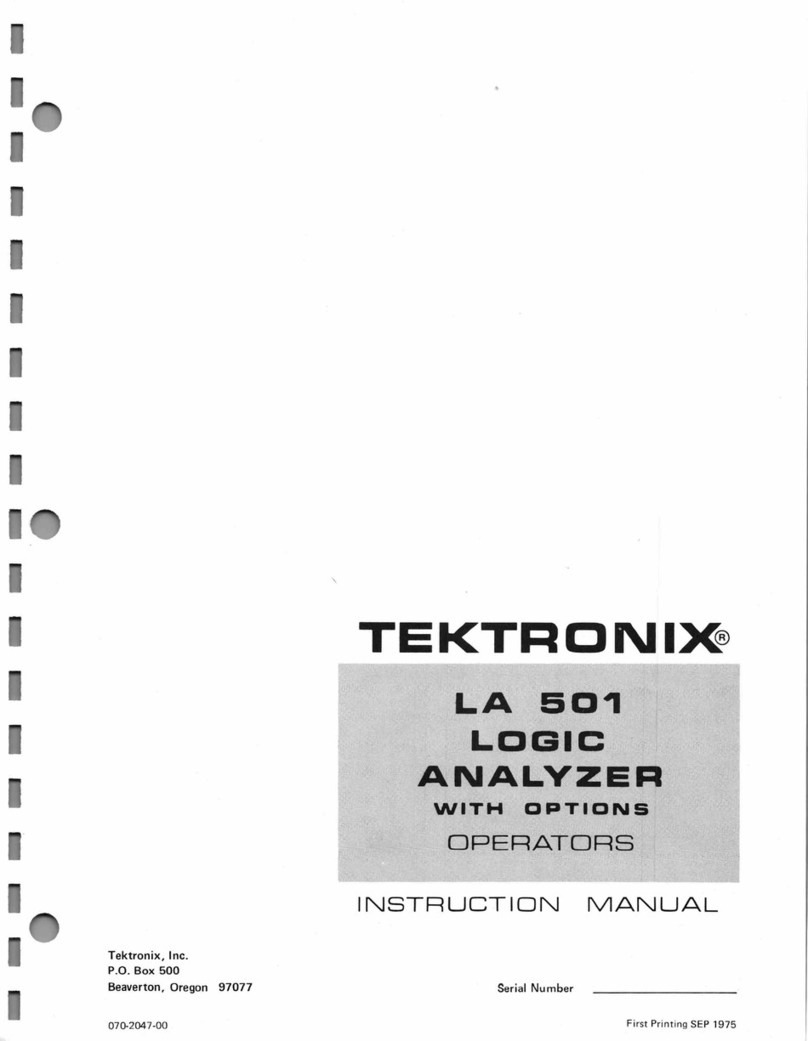
Tektronix
Tektronix LA 501 instruction manual

SICK
SICK InspectorP Rack Fine Positioning operating instructions

Sper scientific
Sper scientific 800050 instruction manual
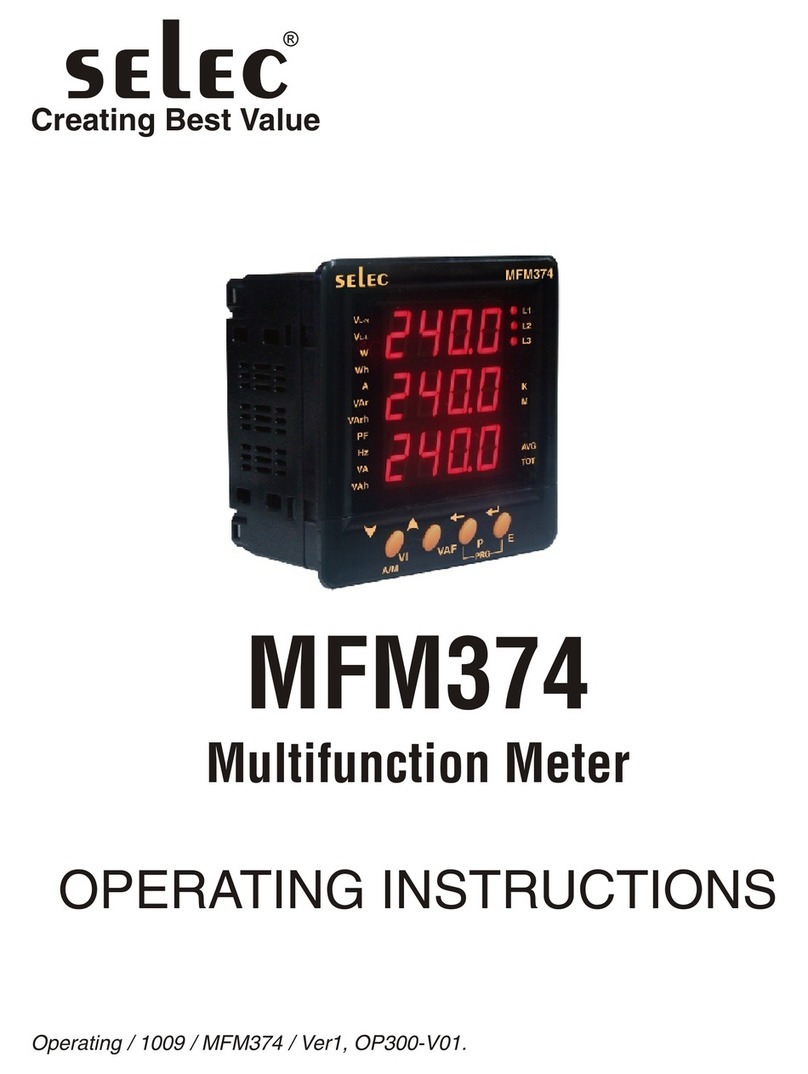
Selec
Selec MFM374 operating instructions
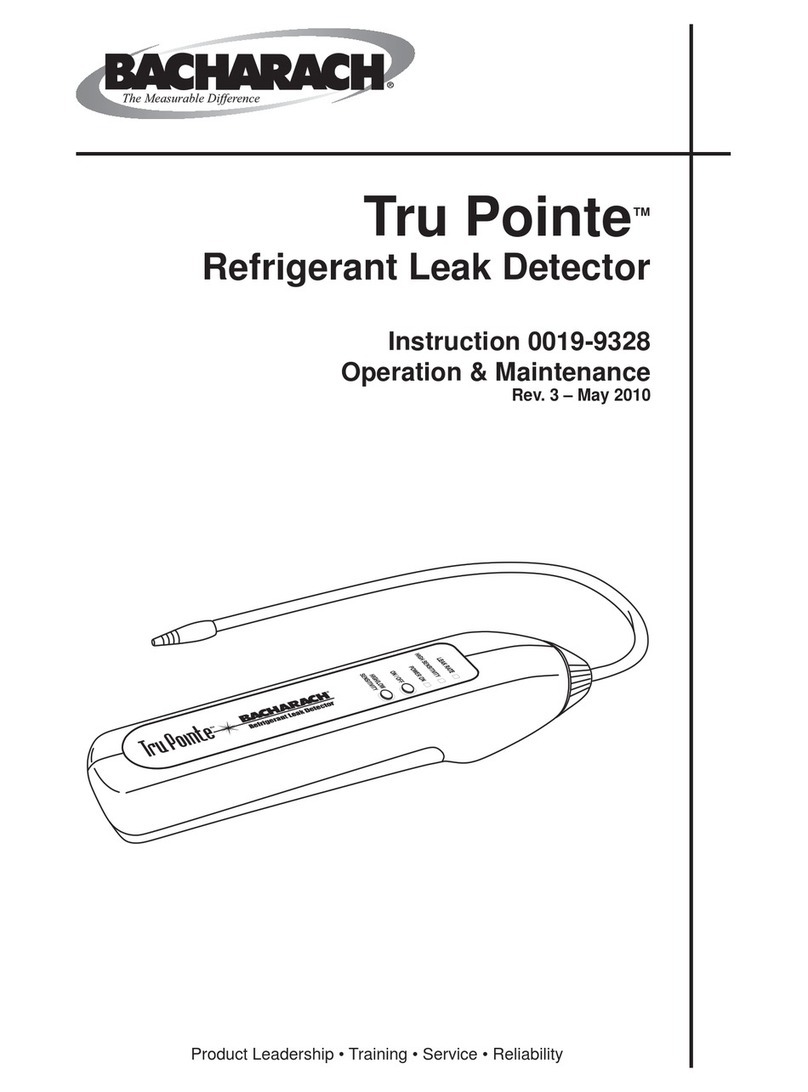
Bacharach
Bacharach Tru Pointe Operation & maintenance guide
